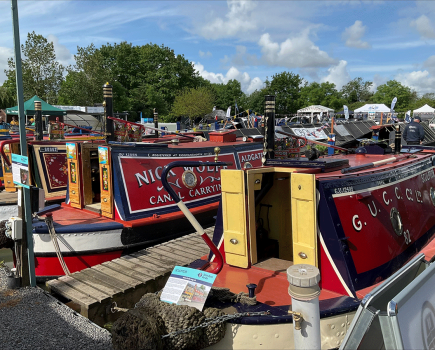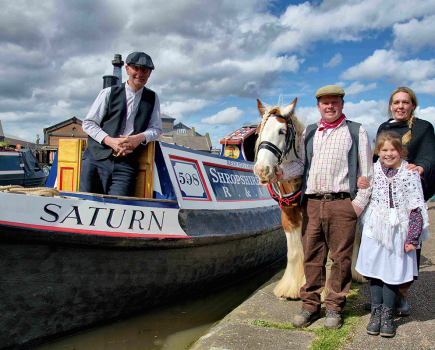By Tony Burton
When asked to name a great canal engineer, most people will come up with at least two names, James Brindley and Thomas Telford. Yet one man, who dominated canal construction during the 1790s, the period known as the years of canal mania, is often ignored. That man is William Jessop.
Jessop was born in 1745 at Stoke Damarel, a parish that included the Devonport dockyard where his father worked as a shipwright and helped John Smeaton in the construction of the new Eddystone lighthouse. As soon as William finished school he was taken on by Smeaton as an apprentice, and he could scarcely have had a better master for Smeaton was unquestionably the most influential civil engineer of the age. The boy worked his way up from apprentice to assistant and was soon helping Smeaton on river improvement schemes, notably the important Calder Navigation. In 1772 he left Smeaton to set out on his own as a consultant engineer, but his first important work was for his old master. He went to Ireland for the first time to survey the line of the proposed Grand Canal that was to link Dublin to the River Shannon. It is often forgotten that Ireland began its major canal construction in 1756, even before the opening of the Bridgewater Canal heralded the beginning of the canal age in mainland Britain. He was to return to Ireland many times as a mature engineer, continuing to work on the Grand Canal and supervising the construction of new docks at Dublin. He married in 1777.
Over the next few years Jessop established a reputation as a reliable and conscientious engineer. He worked on a number of river navigation projects from the Thames to the Upper Ouse, all the time gaining expertise and confidence. Canal work had largely gone into abeyance in the trade slump years caused by the American War of Independence, but when prosperity returned at the end of the 1780s he was ideally placed to make the most of the opportunity: old enough to have the necessary experience, but still young enough to be full of energy and enthusiasm.
His first major work was the Cromford Canal that was to run from the Erewash at Langley Mill to Cromford in Derbyshire, home to Richard Arkwright’s pioneering cotton mill. It was a daunting task as he recognised when he went to survey the ground, which he described as “rugged and Mountainous” and “very ineligible for such a project”. But he took it on anyway, designing a canal with three short tunnels, one major work the 3063 yard (2800m) long Butterley tunnel and two big aqueducts, over the Amber and the Derwent. Both aqueducts gave trouble. Part of the three-arched Amber collapsed, which would have reflected badly on the engineer had he not at once accepted full responsibility and paid �650 out of his own pocket for repairs. He also needed to do remedial work on the Derwent aqueduct when a crack appeared, and again he offered to pay: “I think it common Justice that no one ought to suffer for the faults of another”. There was a brighter side to the picture. He worked closely with another engineer Benjamin Outram and together they established an ironworks at Butterley, which Outram supervised. It was a thriving concern that survives to this day and has a modern connection. It was here that the steelwork was built for the Falkirk Wheel that now unites the Forth & Clyde and Union canals.
Jessop now found himself in demand for a number of projects, one of which was not only to provide work for himself but lucrative business for the new ironworks. Outram had carried out the original survey for the Derby Canal, but Jessop proposed an alternative. He devised a route that would follow the flat country from the Erewash to Derby, but for the hillier route from Derby to the Trent & Mersey he would abandon the canal in favour of a tramway. The cast iron rails, that were fixed on stone sleeper blocks, would be supplied by Butterley. Jessop estimated that a horse could “easily draw down two Waggons with two Tons on each”. The system used an efficient form of containerisation, for the coal was carried on the tramway in wooden boxes that could be lifted off their wheels and dropped snugly into place in the hold of a boat at the wharf.
During the 1790s he was bombarded with offers of work of all kinds, including more visits to Ireland and important land drainage schemes in East Anglia. Among the canal schemes three stand out: the Grand Junction, linking Birmingham to London, the Rochdale, crossing the Pennines and the Ellesmere, now known as the Llangollen. Given the fact that he was Chief Engineer for all three projects it is remarkable that histories often give John Rennie credit for the Rochdale and Thomas Telford is lauded for the Ellesmere’s most spectacular feature. The answer lies partly in Jessop’s own personality. He had little or no interest in fame and plaudits: his reward was always the satisfaction of seeing a job well done.
The Grand Junction displayed all the latest thinking on methods of canal construction. Where the early canals pioneered by Brindley wandered all over the countryside, following the natural contours, Jessop took a far more direct approach, slicing through hills in deep cuttings; crossing valleys on high embankments. This can be seen at its most dramatic in the way in which he tackled one major problem: getting through the Chiltern Hills that lay directly across the line of the canal. His solution was to drive through the ridge in a mile and a half long cutting that at its deepest was some thirty feet below the natural level of the ground. In order to keep this summit level supplied with water he decided to make use of springs near Wendover, but instead of just building a simple feeder he made it into the navigable Wendover Arm. In time, this proved inadequate and three reservoirs were constructed. Another contrast with the earlier canals can be seen at Blisworth. Brindley’s tunnel at Harecastle on the Trent & Mersey had just enough space for a single narrowboat to squeeze through. Jessop’s 3056-yard (2794m) Blisworth tunnel was built to altogether more generous dimensions, being 16ft 6in wide at water level, which meant that boats could travel through in both directions at the same time. The Grand Junction was one of the most impressive, and most successful, canals of the 18th century.
The Rochdale Canal presented a very different challenge. This time he had to cross the Pennines to create a canal that would link the Bridgewater Canal at Manchester to the Calder & Hebble Navigation. The first trans-Pennine route, the Leeds & Liverpool had taken a circuitous route of 127 miles: Jessop’s was a mere 33 miles, but in that length there were 92 broad locks. The engineering of the canal itself was only a part of the story. To keep the canal supplied with water Jessop could not rely on local streams as many of these were used to power the textile mills that lined the route, so he was forced to build two immense reservoirs, Hollingsworth and Blackstone Edge, and later added a third.
The Ellesmere Canal was in many ways the least important of the waterways he was working on. He entrusted much of the actual work to an assistant engineer. He had his own candidate for the job, but the Canal Committee insisted on employing a man who had made quite a success of his job as Surveyor for Shropshire, even though he had no experience of canal construction. His name was Thomas Telford, Jessop laid out the canal with his usual care, using the full range of techniques, cuttings and embankments where appropriate; following the contours where that made more sense. There remained, however, one troublesome obstacle: the route to Llangollen was barred by the deep valley of the River Dee. Various solutions were mooted, but it was Telford who came up with the solution of crossing it with an iron-trough aqueduct, striding across the valley on tall masonry supports. It was, of course, the famous Pontcysyllte. But who should get the credit for it? The idea was undoubtedly Telford’s but the man who took the final decision to build it was the chief engineer, Jessop. It is unfortunate that Jessop’s share in overall responsibility for this masterpiece has been largely overlooked.
Jessop continued to work well into the early 19th century, largely on important docks such as the floating harbour at Bristol and London’s West India Docks. He also seems to have had an eye to the future. In 1801 he proposed building a railway from the Thames at Wandsworth to Croydon. Although it was built as a typical tramway, the Surrey Iron Railway was the very first public railway to be approved by Act of Parliament. Jessop was a quiet, reserved man who enjoyed a settled family life with his wife and children, but he did more than anyone to take canal construction on from the tentative beginnings of the early years to a new age of technological innovation.







